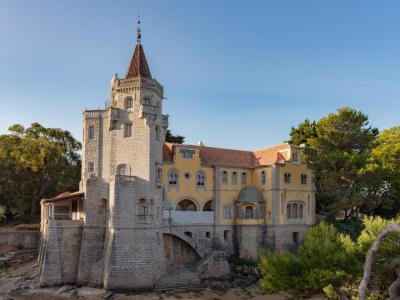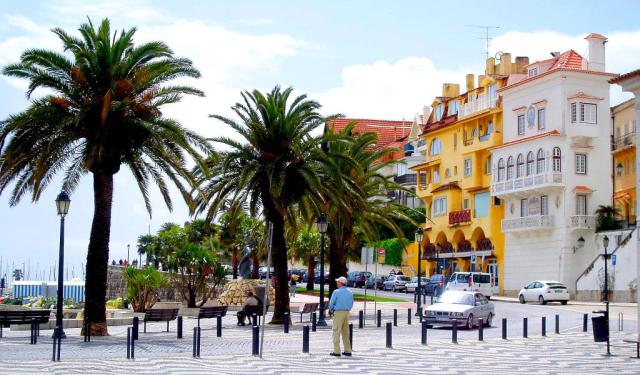
Condes de Castro Guimarães Museum, Cascais (must see)
The Condes de Castro Guimarães Museum, housed within the Palácio dos Condes de Castro Guimarães, is a treasure trove of history and culture located in Cascais. Originally constructed in 1900 as the summer residence of a noble aristocrat, Jorge O'Neil, the palace was known as St Sebastian's Tower. Its eclectic architectural style reflects a blend of various Revivalist influences, including Neo-Romanticism, Neo-Gothic, Neo-Manueline, and Neo-Moorish elements, giving the impression of a medieval castle.
One of the most striking features of the palace is its tower, which extends out into a small cove, creating a captivating and picturesque setting. The irregular rectangular plan of the house spans two, three, and four floors, featuring a plethora of main and triple windows, ornate gargoyles, protruding eaves, and charming porches. Inside, the palace is built around a quadrangular cloister, adding to its architectural allure.
In 1910, the palace changed hands and was acquired by the 1st Count of Castro Guimarães, who, along with his wife, resided there until 1927. During their tenure, many of the remarkable pieces that now adorn the museum were acquired. Notably, the Count purchased a neo-Gothic organ, specially built for him, and acquired rare 16th-century manuscripts, including the valuable "Chronicle of Don Afonso Henriques," chronicling the life of Portugal's first king.
In a significant act of philanthropy, the Count bequeathed the house and its garden to the state upon his death in 1927, with the stipulation that it be used as a museum and art gallery. Thus, on July 12, 1931, the Condes de Castro Guimarães Library Museum was inaugurated, becoming the first museum in Cascais and a testament to the Count's enduring legacy.
One of the most striking features of the palace is its tower, which extends out into a small cove, creating a captivating and picturesque setting. The irregular rectangular plan of the house spans two, three, and four floors, featuring a plethora of main and triple windows, ornate gargoyles, protruding eaves, and charming porches. Inside, the palace is built around a quadrangular cloister, adding to its architectural allure.
In 1910, the palace changed hands and was acquired by the 1st Count of Castro Guimarães, who, along with his wife, resided there until 1927. During their tenure, many of the remarkable pieces that now adorn the museum were acquired. Notably, the Count purchased a neo-Gothic organ, specially built for him, and acquired rare 16th-century manuscripts, including the valuable "Chronicle of Don Afonso Henriques," chronicling the life of Portugal's first king.
In a significant act of philanthropy, the Count bequeathed the house and its garden to the state upon his death in 1927, with the stipulation that it be used as a museum and art gallery. Thus, on July 12, 1931, the Condes de Castro Guimarães Library Museum was inaugurated, becoming the first museum in Cascais and a testament to the Count's enduring legacy.
Want to visit this sight? Check out these Self-Guided Walking Tours in Cascais. Alternatively, you can download the mobile app "GPSmyCity: Walks in 1K+ Cities" from Apple App Store or Google Play Store. The app turns your mobile device to a personal tour guide and it works offline, so no data plan is needed when traveling abroad.
Condes de Castro Guimarães Museum on Map
Sight Name: Condes de Castro Guimarães Museum
Sight Location: Cascais, Portugal (See walking tours in Cascais)
Sight Type: Museum/Gallery
Guide(s) Containing This Sight:
Sight Location: Cascais, Portugal (See walking tours in Cascais)
Sight Type: Museum/Gallery
Guide(s) Containing This Sight:
Walking Tours in Cascais, Portugal
Create Your Own Walk in Cascais
Creating your own self-guided walk in Cascais is easy and fun. Choose the city attractions that you want to see and a walk route map will be created just for you. You can even set your hotel as the start point of the walk.
Cascais Introduction Walking Tour
A charming seaside town some 30 minutes' drive away from the capital of Portugal, Cascais, holds a unique place in the country's history and culture. It started life as a humble fishing village, with the Romans, Visigoths, and Muslims leaving their mark on the area. Records dating back to Roman times suggest that it served as a stopover point for travelers along the coastline.
The... view more
Tour Duration: 2 Hour(s)
Travel Distance: 2.4 Km or 1.5 Miles
The... view more
Tour Duration: 2 Hour(s)
Travel Distance: 2.4 Km or 1.5 Miles

